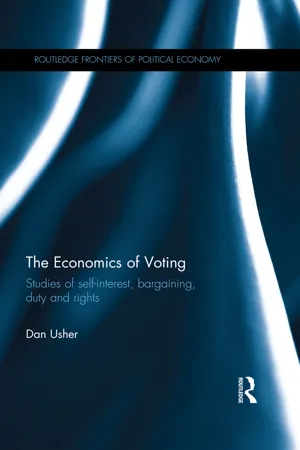Economics
Condorcet Paradox
The Condorcet Paradox refers to a situation in which majority preferences are inconsistent when individuals vote on multiple options. This paradox arises when there is no clear winner because different groups of voters prefer different options. It highlights the challenges of aggregating individual preferences into a collective decision, and it has implications for voting systems and decision-making processes.
Written by Perlego with AI-assistance
Related key terms
2 Key excerpts on "Condorcet Paradox"
- eBook - ePub
Game Theory in the Social Sciences
A Reader-friendly Guide
- Luca Lambertini(Author)
- 2011(Publication Date)
- Routledge(Publisher)
Condorcet proposed a way out of the paradox – known as the Condorcet method – in order for majority voting to yield a winner. In summary, the method consists in pitting every candidate against every other candidate in a series of imaginary one-on-one contests, with pairwise counting. I will not delve into the details of the different procedures that can be adopted to solve the paradox, but this way out is precisely what is being adopted in the US presidential elections and elsewhere – yielding a winner, but not necessarily selecting as such the candidate who would have the largest consensus across the population of voters.A direct, although much later, follow-up to the Condorcet Paradox is Arrow's impossibility theorem, or Arrow's paradox (Arrow, 1951). Arrow's theorem proves that, when voters face three or more options, there exists no voting system capable of converting individually ranked preferences into a community-wide ranking while also meeting a certain set of criteria. An equivalent formulation of the theorem is that, in the absence of restrictions on either individual preferences or neutrality of the constitution as to feasible alternatives, there exists no social choice satisfying a set of seemingly plausible requirements. The result generalizes the Condorcet voting paradox.To make things as simple as possible, one has to think that the subject of Arrow's theorem is the problem of aggregating in an acceptable and satisfactory way the preferences of a number of individuals. This aggregation procedure is supposed to produce a system of what this literature calls social preferences, through some generally accepted mechanism that is labelled as a social welfare function, which has to meet a set of sensible conditions or rules. The complete list of such ‘plausible requirements’ includes the following.1 - eBook - ePub
- Dan Usher(Author)
- 2015(Publication Date)
- Routledge(Publisher)
The Condorcet jury theorem pertains to situations where people differ in opinions rather than interests. One among a set of options is best for everybody but people disagree about which option that is. The theorem establishes that voting is likely to find the best option when each person has a better than even chance of being right. Depiction of contemporary politics as a contest between left and right can be seen as an attempt to confine platforms of political parties within the boundaries of these theorems. Otherwise, majority rule voting may be intransitive and inefficient: intransitive in succumbing to a paradox of voting where none of the options in an election defeats all other options in a pairwise vote, and inefficient in that the loser in an election may, in a sense to be described, be preferable to the winner. The potential inefficiency and intransitivity of majority rule voting may be mitigated by vote trading which is at once the rationale for cost–benefit analysis and a way for minorities of voters who care passionately about one issue above all others to thrust their cherished policies onto the platforms of competing parties, even when those policies are opposed by the great majority of voters. Much depends on what people vote about. An exploitation problem has for centuries stood as the principal objection to majority rule voting. A majority of voters – any majority whatsoever – can employ the power of the vote to dispossess the corresponding minority completely. A majority of the poor can totally dispossess the rich. A majority of one religion can totally dispossess the minority of other religions. Fear of exploitation is the rationale for divided government and for the constitutional protection of civil and property rights. The exploitation problem is compounded by the danger of the emergence of an elected dictator who will employ the powers of government to preserve his tenure in office indefinitely. Much also depends on who votes and who abstains
Learn about this page
Index pages curate the most relevant extracts from our library of academic textbooks. They’ve been created using an in-house natural language model (NLM), each adding context and meaning to key research topics.

